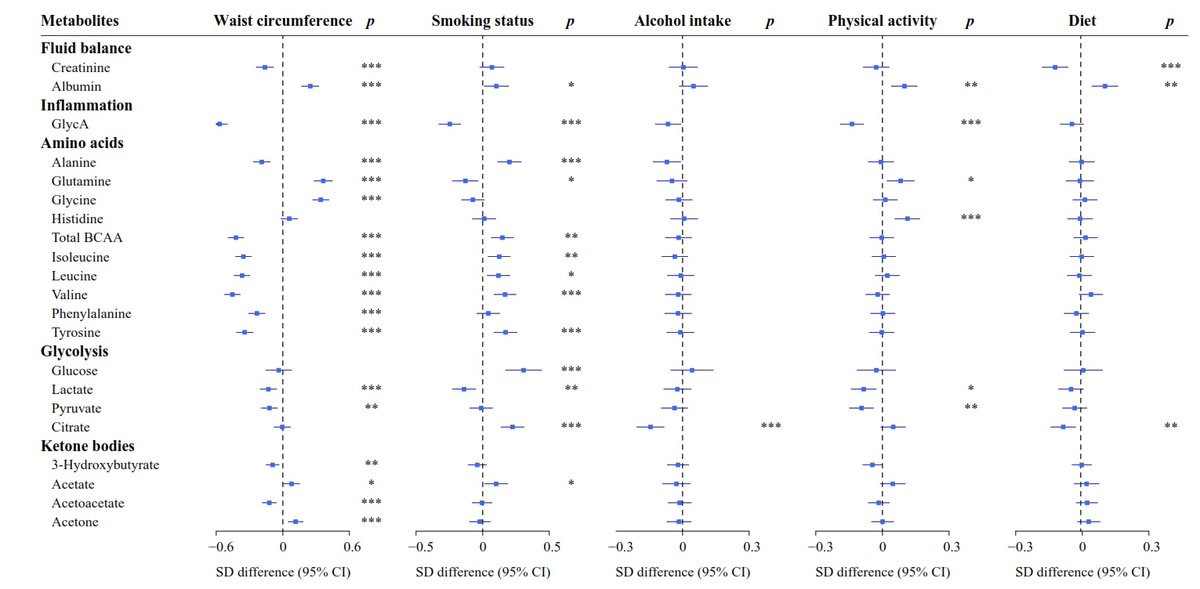
This one found adherence to multiple healthy lifestyle factors to be associated with improved circulating metabolites from different pathways, with fatty acids mediating the association between all 5 lifestyle factors and the risk of CVD in individuals with diabetes. 







- This study aimed to provide a comprehensive assessment of the associations of multiple lifestyle factors (waist circumference, smoking status, alcohol intake, physical activity, and diet) with nuclear magnetic resonance (NMR) metabolomics among individuals with diabetes.
- Adherence to healthy lifestyle factors, including non central obesity, non-current smoking, moderate alcohol intake, physically active, and healthy diet, was associated with 44 plasma metabolites across multiple metabolic pathways.
- Approximately half of metabolites showed mediating effect between at least one lifestyle factor and CVD risk, which were mostly lipoprotein particles and fatty acids.
- Though metabolites that associated with lifestyle factors were mostly different across the 5 lifestyle factors, the pattern of association were consistent between fatty acids and all lifestyle factors.
- Fatty acids mediated the association between all 5 lifestyle factors and the risk of CVD with mediation proportion ranging from 10.9% to 39.9%
- The association between waist circumference and CVD risk was mediated by lipoprotein particle concentration, fluid balance, fatty acids, inflammation, and amino acids...
...with mediation proportion (95%CI) of 16.9% (5.9%, 39.7%), 8.8% (4.2%, 17.7%), 22.7% (10.6%, 42.1%), 21.2% (10.8%, 36.4%), and 4.1% (1.4%, 11.0%), respectively.
- The association between non-current smoking and reduced CVD risk were mediated by lipoprotein particle concentration, fluid balance, fatty acids, and inflammation...
...with mediation proportion of 9.5% (4.3%, 19.6%), 7.2% (2.4%, 19.4%), 12.2% (5.5%, 24.9%), and 9.6% (4.3%,20.1%), respectively.
- Only fatty acids showed statistically significant mediating effects (16.8%) in the inverse association of alcohol intake and CVD risk.
- Lipoprotein particle concentration, fluid balance, fatty acids, and inflammation mediated 8.1% (2.5%, 22.9%), 13.6% (4.8%, 32.7%), 15.4% (5.5%, 36.4%), and 15.3% (5.7%, 34.9%) of the association between adequate physical activity and lower CVD risk, respectively.
- The proportion of reduced CVD risk associated with healthy diet mediated by lipoprotein particle concentration, fluid balance, and fatty acid was 11.4% (4.1%, 28.2%), 41.1% (14.5%, 74.2%), and 26.8% (9.4%, 56.4%), respectively.
- Adherence to 5 healthy lifestyle factors were all associated with higher level of omega-3/FA, omega 6/FA, PUFA/FA, LA/FA, DHA/FA, and PUFA/MUFA ratios, and lower level of MUFA/FA, and SAFA/FA ratios, though few estimates did not reach significance.
- All 44 assayed metabolites were associated with at least one lifestyle factor, and PUFA/FA, MUFA/FA, and PUFA/MUFA ratios were simultaneously associated with all 5 lifestyle factors.
- "...we found that adherence to multiple healthy lifestyle factors was associated with improved circulating metabolites from different pathways, suggesting that comprehensive lifestyle interventions are not redundant but could be combined for greater benefits"
Healthy lifestyle, plasma metabolites, and risk of cardiovascular disease among individuals with diabetes
doi.org/10.1016/j.athe…
#nutrition #diet #MetabolicSyndrome #Obesity #exercise #smoking #alcohol
doi.org/10.1016/j.athe…
#nutrition #diet #MetabolicSyndrome #Obesity #exercise #smoking #alcohol

Thanks to @heniek_htw for the heads up on this one!
• • •
Missing some Tweet in this thread? You can try to
force a refresh









